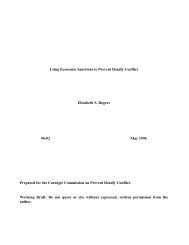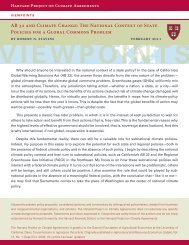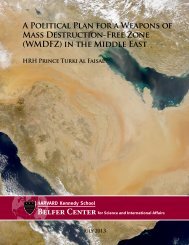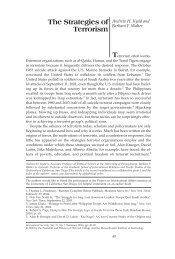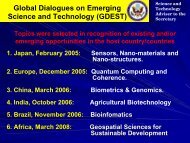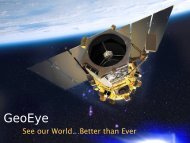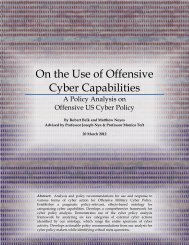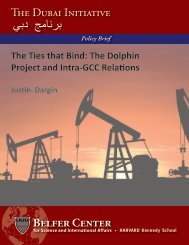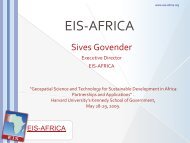Plutonium Mountain - Belfer Center for Science and International ...
Plutonium Mountain - Belfer Center for Science and International ...
Plutonium Mountain - Belfer Center for Science and International ...
- No tags were found...
Create successful ePaper yourself
Turn your PDF publications into a flip-book with our unique Google optimized e-Paper software.
the U.S. hydronuclear experiments <strong>and</strong> had <strong>for</strong> years studied the mysterious activities recorded<br />
by satellites at the Semipalatinsk test site. He visited the area in early 1995, <strong>and</strong> from that <strong>and</strong><br />
other sources, the details of the Soviet hydronuclear <strong>and</strong> safety tests were confirmed. The in<strong>for</strong>mation<br />
suggested a “large number” of tests between 1967 <strong>and</strong> 1976 at the Semipalatinsk site.<br />
In November, 1995, Stillman <strong>and</strong> colleagues at Los Alamos wrote a memo to Hecker about the<br />
potential <strong>for</strong> another nightmare scenario – that plutonium might be buried in the tunnels of Degelen<br />
<strong>Mountain</strong> or elsewhere around Semipalatinsk in <strong>for</strong>ms that thieves could extract. They proposed<br />
a rapid ef<strong>for</strong>t to carry out an on-site assessment, <strong>and</strong> then develop a plan <strong>for</strong> cleaning the<br />
site up. Stillman titled his memo, “Project Amber: Elimination of a Potential Source of Special<br />
Nuclear Materials.” 25<br />
The memo recounted that Kadyrzhanov <strong>and</strong> other Kazakh scientists had told Stillman of their<br />
concern that plutonium remained in a remote area unprotected by fences or guard posts. A summary<br />
of the in<strong>for</strong>mation suggested that “problem will not go away,” <strong>and</strong> added that there was<br />
more than 150 kilograms (330 pounds) of “special nuclear material” at the location (a term of art<br />
<strong>for</strong> material that can be used to fuel nuclear bombs), available <strong>for</strong> “collection without detection.”<br />
There was no security, nomads <strong>and</strong> herdsmen roamed at will, <strong>and</strong> there had been “discovery of<br />
surface gold on site.” 26<br />
Stillman wrote in the “Project Amber” memo:<br />
If the tests were similar to tests conducted in the US (in particular at TA-49 in Los Alamos),<br />
we would expect the material deposited in the trenches to contain several hundred …<br />
kilograms of weapons grade special nuclear materials (Pu, <strong>and</strong> possibly highly-enriched<br />
uranium)…. Because this site is so remote from the main test site, the presence of this<br />
significant amount of plutonium poses a serious threat to the proliferation goals of both the<br />
US <strong>and</strong> Kazakhstan. Deposits of gold have recently been discovered in the immediate area<br />
surrounding this site, thereby increasing the potential of increased access by the general<br />
public. This site provides a potential ‘Pu mine’ <strong>for</strong> a potential proliferator unless it is<br />
contained or cleaned up in the near future. 27<br />
Stillman <strong>and</strong> his colleagues laid out a plan <strong>for</strong> dealing with what they called “a potential <strong>and</strong> accessible<br />
source of weapons-grade nuclear material.” At the time, the main proliferation concern<br />
was Iran, which was thought to be hunting in the <strong>for</strong>mer Soviet Union <strong>for</strong> weapons-grade nuclear<br />
materials. Stillman estimated that containment <strong>and</strong> remediation of the materials at the site might<br />
cost up to $1 million.<br />
Nothing happened immediately. But within weeks of Hecker’s retirement in late 1997, he began<br />
to focus on the problem outlined in the Project Amber memo. One of the side benefits of the<br />
1994 HEU removal from Kazakhstan was that the U.S. provided funds, through the <strong>International</strong><br />
<strong>Science</strong> <strong>and</strong> Technology <strong>Center</strong>, to Kazakh nuclear institutes. 28 This, in turn, promoted closer<br />
25<br />
The 1995 Degelen <strong>Mountain</strong> visit is reported in Hecker, “Dealing with Kazakhstan’s Nuclear Legacy.”<br />
26<br />
Los Alamos National Laboratory memor<strong>and</strong>um, written by staff scientists <strong>for</strong> Siegfried S. Hecker, “Nuclear Proliferation<br />
Problem.” The paper was probably written about the time of the Project Amber memo or shortly thereafter.<br />
27<br />
“Project Amber: Elimination of a Potential Source of Special Nuclear Materials.” November 30, 1995. Pu is the chemical<br />
symbol <strong>for</strong> plutonium.<br />
28<br />
The <strong>International</strong> <strong>Science</strong> <strong>and</strong> Technology <strong>Center</strong> was established in 1992 by the United States, European nations, <strong>and</strong> Japan<br />
10<br />
<strong>Plutonium</strong> <strong>Mountain</strong>: Inside the 17-year mission to secure a dangerous legacy of Soviet nuclear testing



